
| By KYAW ZWA MOE | Saturday, December 1, 2007 |
(Page 2 of 7)
In retrospect, it took weeks for the world to see a picture of the 1988 demonstrations. But in September, photographs and video clips arrived within minutes of the start of demonstrations in cities such as Rangoon and Mandalay and more and more updated information flowed in by the minute.
Meanwhile, Burmese exiled media groups went into high gear, updating information and images on a round-the-clock basis. Web sites were overloaded with people seeking the latest news.
The media served as the people’s link to politicians worldwide. The junta had its soldiers and guns. The people had the media and the truth in words and pictures.
Without the constant media coverage, the pressure on the junta would not have been as strong.
Immediately after the junta’s troops opened fire on the protesters, UN Secretary-General Ban Ki-moon urgently dispatched special envoy Ibrahim Gambari to Burma to seek talks between the generals and opposition leader Aung San Suu Kyi. His second visit made small breakthroughs that may yet yield significant steps forward.
Also, prominent people like US first lady Laura Bush and Hollywood star Jim Carrey voluntarily made public appeals for support, helping to raise people’s awareness.
The world’s largest countries and political groups, including the UN, the EU and Asean, all spoke out calling for reconciliation and democracy. Some countries, including traditional junta allies, such as China and Singapore, took noticeably harder stands against the regime.
Without international pressure, the junta would not have appointed a liaison officer to deal with detained opposition leader Suu Kyi and allowed her to meet the UN envoy and her party’s senior leaders for the first time in three years.
Without democratic icon Suu Kyi, any talks involving a path to democratic compromise would appear half-hearted. Her stature extends beyond Burma’s domestic politics, and she has become the property of democracy movements worldwide.
Throughout the bloodshed and arrests, another important message came through: that the public anger was largely directed against the 11 members of the ruling junta, the State Peace and Development Council.
In accordance with the hierarchy of the military, Than Shwe is the man who called the shots. Without his green light, no one would have ordered the troops to open fire.
Because of the regime’s intransigence, new, tougher sanctions were imposed by the US, the EU, Australia and other countries, directed at business tycoons such as Tay Za and others who help keep the junta in power.
Really, it all comes down to one man: Than Shwe is the junta; the junta is Than Shwe.
Than Shwe is the key. He is the only person who can open up the dialogue process. For now, he seems perfectly comfortable in his new capital, Naypyidaw, where he seldom sees the daily suffering of the people of Burma.
At least this time, the people’s suffering and anger were witnessed throughout the world, thanks to many brave citizens. The Irrawaddy acknowledges all the people who made sacrifices for freedom. They are all heroes of Burma’s 2007 uprising and many of them are featured on the following pages.
Without them, there would be no hope at all.
Pro-Democracy advocates
The Alliance of All Burmese Buddhist Monks
Describing themselves as The Alliance of All Burmese Buddhist Monks, the author of a widely distributed leaflet gave the military government until September 17 to issue an apology for its brutal suppression of demonstrating monks in Pakkoku by police, soldiers and pro-government paramilitary thugs. When the junta failed to apologize, the alliance urged all Buddhist monks in the country to hold a “patam nikkujjana kamma”—a boycott of alms from members of the military regime and its supporters. The call prompted tens of thousands of monks and civilians around Burma to stage the largest protest marches against the military government in nearly 20 years, calling for better living conditions for the people and national reconciliation.
 |
| Columns of monks and their supporters stage a march in September [Photo: Thierry Falise/The Irrawaddy] |
When the protests began, no one knew the identity of the leaders of the monks’ alliance.


Thailand Hotels
Bangkok Hotels
China Hotels
India Hotels

|

